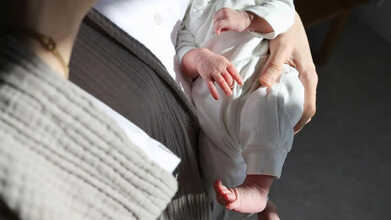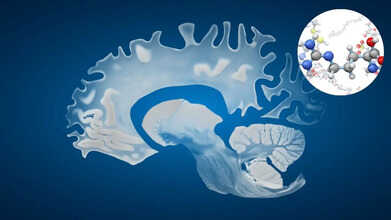- Health Conditions A-Z
- Health & Wellness
- Nutrition
- Fitness
- Health News
- Ayurveda
- Videos
- Medicine A-Z
- Parenting
This Sleeping Position Could Worsen A Covid Symptom, NHS Cautions

Credits: Canva
People who are dealing with a particular Covid symptom have been given a cautionary note by the NHS. The way you position yourself while resting or sleeping can actually aggravate how you feel. As cold weather settles over the UK, the chances of picking up seasonal infections such as colds, flu or COVID-19 begin to rise. These viruses thrive in lower temperatures and spread more easily when people spend more time indoors.
For most individuals, Covid clears up within a few days or a couple of weeks without needing specialised care. Because of this, the NHS advises plenty of rest to support recovery. It also recommends staying home and limiting contact with others if you have symptoms and do not feel well enough to go about your usual activities. The health service further offers specific guidance for anyone struggling with a cough.
NHS Issued A Warning For Certain Covid Symptoms
Cough remains one of the most common signs of Covid, especially when it becomes “continuous.” The NHS describes this as coughing repeatedly for more than an hour, or having three or more coughing spells in a single day.
To help ease the discomfort, the NHS advises: “Do not lie on your back if you have a cough – lie on your side or sit upright instead.”
This suggestion is echoed by Dr Elizabeth Rainbolt. In an interview with the Cleveland Clinic, she noted that lying flat on your back can worsen postnasal drip.
Why Sleeping Position Matters When You Have a Cough
For people dealing with a dry cough, resting on your side rather than on your back may help limit irritation. Dr Rainbolt added: “Raising your head is usually the best position for sleep. You can do this by adding an extra pillow or slightly lifting the head of your bed. This keeps drainage from settling at the back of your throat.”
Anyone coping with a persistent cough should speak with a pharmacist to explore available remedies.
Symptoms
Along with coughing, the NHS lists several other signs of Covid, including:
- A high temperature or shivers (chills) – a high temperature means your chest or back feels hot to the touch (you do not need to check it with a thermometer)
- A change or loss in your sense of smell or taste
- Shortness of breath
- Fatigue
- Aches in the body
- Headache
- Sore throat
- Blocked or runny nose
- Poor appetite
- Diarrhoea
- Nausea or vomiting
Covid Recovery Tips From Health Experts
- Make sure you get enough rest to support your body’s recovery.
- Drink plenty of water to stay hydrated; aim for urine that is light yellow or clear.
- Use paracetamol or ibuprofen to ease discomfort if needed.
- A teaspoon of honey may soothe a cough, but never give honey to infants under 12 months.
- For breathlessness, lower the room temperature or open a window to improve airflow.
- Practice slow, controlled breathing: inhale through your nose and exhale gently through pursed lips, like blowing out a candle.
- Sitting upright in a chair can help ease shortness of breath.
- Keep your shoulders relaxed to prevent tension that can worsen breathing.
- Lean forward slightly, supporting yourself with your hands on your knees or a stable surface, to make breathing easier.
- Avoid using fans to cool your room, as they may disperse viral particles.
- Stay calm if you feel breathless, as anxiety can intensify the sensation.
Breastmilk In Parts Of Bihar Found Contaminated With Uranium – How It Could Affect Newborns?

Credits: Canva
A new scientific investigation has drawn attention to alarming levels of uranium in the breastmilk of nursing mothers across six districts in Bihar. The findings suggest possible health risks for infants who depend entirely on breastmilk in their first months.
Published in Scientific Reports, the study is the first to examine uranium contamination in breastmilk from the Gangetic belt of Bihar, a region already known for widespread exposure to arsenic, lead, mercury and other heavy metals.
Researchers collected breastmilk samples from 40 mothers aged 17 to 35 from Bhojpur, Samastipur, Begusarai, Khagaria, Katihar and Nalanda. Each participant gave informed consent, and the team documented breastfeeding habits, child health, and residential history. The work was carried out by scientists from Mahavir Cancer Sansthan & Research Centre (Patna), Lovely Professional University, NIPER-Hajipur and other collaborating institutions.
Breastfeeding Samples Show Uranium In Bihar
The most concerning outcome was that every single sample contained detectable uranium. As per NTDV, the authors noted that “100% of lactating mothers had their breastmilk highly contaminated with uranium.” The concentrations varied, reaching as high as 5.25 μg/L in some cases. Although there is no globally accepted safety limit for uranium in breastmilk, the presence of any radioactive heavy metal in an infant’s only food source raises immediate health worries.
District Wise Readings
Uranium concentrations were not uniform across districts. The data showed the highest average burden in Khagaria, followed by Samastipur, Begusarai, Katihar, Bhojpur and Nalanda. Katihar had the single highest recorded value at 5.25 μg/L, while Khagaria had the highest mean value of 4.035 μg/L. Nalanda showed the lowest average level at 2.354 μg/L. Spatial mapping in the study also indicated a distinct distribution pattern, suggesting local environmental and geological influences.
Can Breastmilk Contaminated with Uranium Affect Newborns?
To assess potential harm, the team estimated uranium intake by infants using Monte Carlo modelling with 10,000 simulations. The analysis suggested that about 70 percent of infants could face non-cancer health effects if exposure continues.
The study stressed that babies are far more vulnerable than adults because their organs are still developing, their body weight is low, and they eliminate toxins less efficiently. While the analysis did not show a cancer risk from the detected levels, the exposure was high enough for researchers to warn about possible kidney damage and other non-carcinogenic effects in infants.
Interestingly, as per NDTV, a senior scientist with the National Disaster Management Authority said the study does not signal a public health threat. According to him, the uranium levels detected in the Bihar samples fall well below the limit set by the World Health Organization.
Is Uranium In Breastmilk Worrisome?
Though uranium is known for its radioactive properties, its chemical toxicity poses a more immediate threat. Since infants absorb heavy metals more easily, uranium exposure in early life may cause long-term issues, including:
• Kidney damage and impaired kidney function
• Problems in neurological development, affecting behaviour and cognition
• Possible increased cancer risk later in life
• Interference with bone, immune and motor development
• The ability to cross the placental and blood-brain barriers, potentially harming brain growth
The study did not test water or food consumed by the participating mothers, but the authors referred to previous research that documented high uranium levels in 273 groundwater samples from Bihar.
Districts such as Supaul, Nalanda and Vaishali recorded extremely elevated levels, far above the WHO guideline of 30 μg/L for drinking water. Since groundwater is widely used for drinking and farming in Bihar, the contamination likely stems from natural geological deposits, excessive groundwater extraction, phosphate fertilisers, industrial waste and inadequately treated sewage. Earlier surveys show that uranium contamination is widespread, with at least 11 districts reporting unsafe concentrations in drinking water,
Should Mothers Stop Breastfeeding Their Newborns?
The researchers make it clear that mothers should not stop breastfeeding because of these findings. They emphasise that breastfeeding remains the healthiest and most beneficial source of nutrition for infants, and should only be discontinued if a doctor advises it. While the uranium levels observed are a cause for concern, the study notes that they are not a reason to halt breastfeeding on their own.
This Everyday Supplement May Quietly Cut Your Alzheimer’s Risk, New Study Suggests

Credits; Canva
New findings suggest that a common supplement might play a role in lowering the risk of Alzheimer’s disease. Researchers have found that a naturally occurring amino acid may help stop the build-up of harmful plaque in the brain. Alzheimer’s remains the leading cause of dementia and often brings changes in memory, communication and behaviour.
Experts believe the condition begins when certain proteins collect in and around brain cells. One of these proteins, amyloid, can form thick deposits that interfere with how the brain functions. Recent work now indicates that a simple oral supplement may help limit amyloid levels.
A Supplement That May Help Protect The Brain
The study, published in Neurochemistry International, showed that arginine, a naturally present amino acid, could reduce the clumping of amyloid and lessen its damaging effects in animal models of Alzheimer’s.
What Is Arginine?
Arginine, sometimes listed as l-arginine, helps the body build proteins and is found in foods such as meat, fish, nuts, seeds and dairy. It is also available in supplement form. Researchers stressed that the doses used in their experiments were specific to the study and do not match the amounts sold in commercial supplements. Professor Yoshitaka Nagai, who led the research, said the results suggest that arginine has the ability to curb this build-up both in lab testing and in living organisms.
Professor Nagai explained that the discovery is especially encouraging because arginine already has a well-established safety record and is relatively affordable. This combination, he noted, makes it a promising candidate for future therapeutic use. Reports from Science Daily highlight that the animals given oral arginine developed fewer amyloid plaques and showed a drop in insoluble Aβ42 in the brain. These mice also performed better in behavioural assessments and showed reduced activity of inflammatory genes linked to the progression of Alzheimer’s.
How Arginine Affected Brain Changes In Mice
The research team believes that these results may help spark new ideas for preventing Alzheimer’s or slowing its progression. Professor Nagai said that the findings could be useful not only for Alzheimer’s but also for other disorders linked to abnormal protein folding. He added that because arginine is low-cost and already considered safe for general use, it could move into clinical testing more quickly than many experimental drugs. Even so, researchers cautioned that more preclinical work and human-based studies are needed before any firm conclusions can be made about recommended doses or long-term impact.
Signs of Alzheimer’s disease
According to the NHS, early Alzheimer’s often begins with noticeable memory problems. A person in the initial stages may show signs such as:
• Forgetting recent events or conversations
• Misplacing belongings
• Struggling to recall names of common places or objects
• Having difficulty finding the right words
• Repeating questions
• Showing weaker judgement or taking longer to make decisions
• Becoming less adaptable or more resistant to changes
Anyone who notices these changes in themselves or a loved one should consider seeking advice from a GP.
Scientists Say A Type 1 Diabetes Cure May Be Close, Raising Hope for Life Without Insulin Shots

Credits: Canva
A research team at Stanford School of Medicine has reported an experimental treatment that appears to stop type 1 diabetes in its tracks in mice. The method not only prevented the disease in animals on the verge of developing it, but also restored normal blood sugar levels in mice already living with full-blown diabetes.
The approach stands out because it merges immune cells from the patient and a donor, creating a shared immune system that accepts the transplanted tissue without heavy immunosuppressive drugs. The mice remained stable for at least four months, which is considered significant in early-stage diabetes research.
Scientists believe the strategy could eventually help humans living with type 1 diabetes and may also support safer organ transplantation, as per Science Direct.
What Is Stem Cell Therapy For Diabetes?
Stem cell therapy for diabetes aims to rebuild the body’s ability to make its own insulin by creating new, working beta cells in the pancreas. In this method, stem cells collected from sources such as bone marrow or umbilical cord blood are guided to develop into insulin-producing cells. These cells are then placed into the patient’s body to help regulate blood sugar more naturally. According to the National Institutes of Health, this approach may lessen a person’s dependence on insulin shots and other diabetes medicines.
How the Hybrid Immune System Works?
Type 1 diabetes develops when the body’s own defense system begins to destroy insulin-producing beta cells in the pancreas. Replacing these cells through islet transplantation is a known option, but the recipient’s immune system often attacks the donor cells as well.
In this study, researchers first “soft-reset” the mouse immune system with a preparation process that included a targeted immune inhibitor, a small dose of radiation, and selected antibodies. Once the animals were conditioned, scientists infused a mix of donor blood stem cells and donor islet cells.
This created a blended immune environment where the new islet cells were not treated as intruders. The mice regained the ability to regulate blood sugar, and the transplanted tissue stayed largely free from destructive inflammation.
Why the Findings Matter
Lead researcher Seung Kim explained that the method addresses two challenges at once. It replaces the lost insulin-producing cells and calms the autoimmune process that caused the damage in the first place. None of the animals developed graft-versus-host disease, a serious complication that often appears in cross-donor cell therapies in humans.
The results build on earlier studies suggesting that donor-recipient immune cell combinations can help prevent transplant rejection. The promising outcome raises hope for human trials, although several hurdles remain.
What Still Needs to Be Solved?
Islet cells for transplantation can only be collected after a donor’s death, and they must come from the same person who provides the blood stem cells. The number of cells required for a human-scale procedure is also unclear.
Researchers are now exploring ways to improve the survival of donor cells and to grow replacement cells from pluripotent human stem cells in the lab. The team believes these steps could bring this treatment closer to clinical use.
Kim called the possibility of adapting the findings for people “very encouraging,” noting that some of the immune-reset techniques used in the study already exist in clinical care for other conditions.
© 2024 Bennett, Coleman & Company Limited

